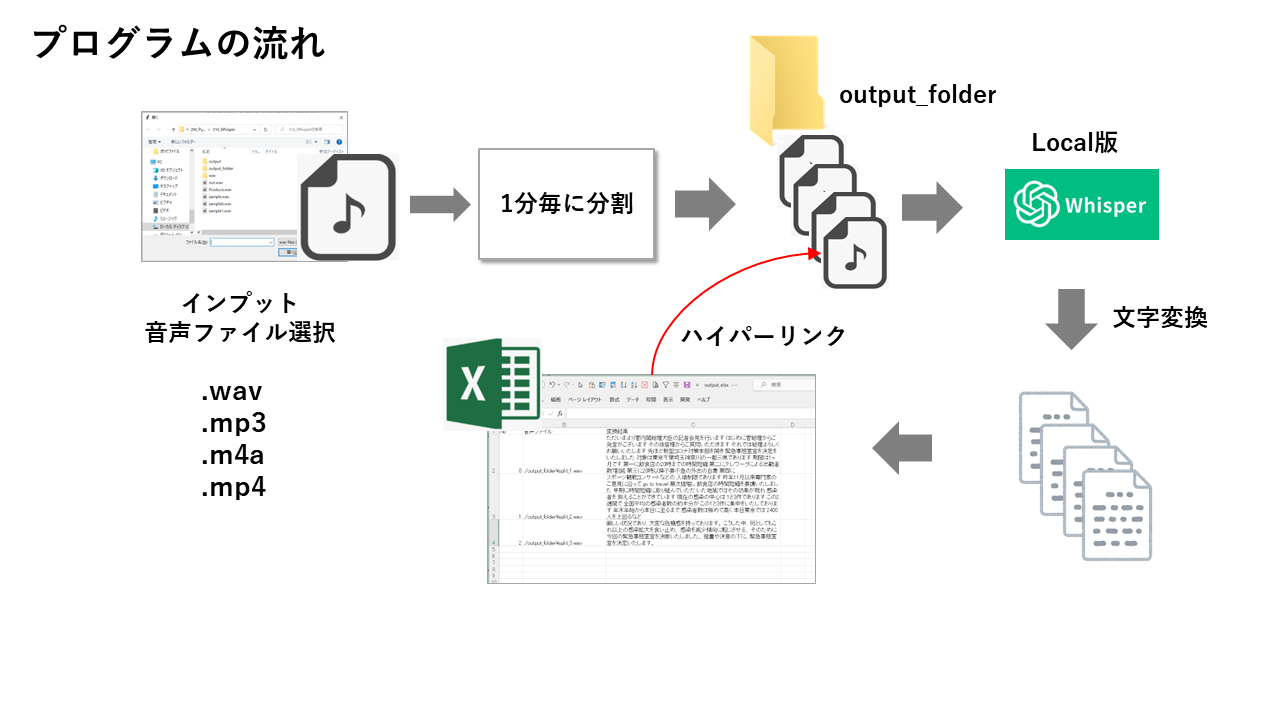はじめに
今回は、音声認識AIのWhisperをローカルインストールして、Pythonで利用する方法をご紹介していきます。
OpenAIのWhisperは有料でAPI利用も出来ますが、今回は、無料でローカルインストールして使う方法をご紹介しています。
環境
Windows10
Python3.10.0
VENV (仮想環境構築)
CPU Intel Corei5
GPU NVIDIA Geforece GTX-1650 (GPUは無くても動きます)
#主な利用ライブラリー
openai-whisper 20230314
torch 2.0.1+cu117
torch 2.0.1(GPUが無い場合)
pandas 2.1.0
openpyxl 3.1.2
pydub 0.25.1
プログラムのイメージ
YouTubeでの解説:
仮想環境の構築方法やGPUのセットアップ方法、各モデルの精度や処理速度の比較など、Youtubeで詳しく解説していますので、ぜひ、ご覧ください。
https://youtu.be/Yv75_hU0hdg
サンプルソース1
YouTubeで紹介している音声ファイルを文字変換して出力するプログラムソースです。
import whisper
import datetime
print("start:", datetime.datetime.now().strftime("%Y-%m-%d %H:%M:%S"))
model = whisper.load_model("base")
result = model.transcribe("sample1.wav")
print(result["text"])
print("end:", datetime.datetime.now().strftime("%Y-%m-%d %H:%M:%S"))
サンプルソース2
YouTubeで紹介している最終的なプログラムソースです。
import whisper
import os
import tkinter.filedialog
from pydub import AudioSegment
import pandas as pd
from openpyxl import Workbook
from openpyxl.utils.dataframe import dataframe_to_rows
def split_audio_file(file_path, output_folder):
# 入力ファイルの拡張子を取得
file_extension = os.path.splitext(file_path)[1].lower()
file_name = os.path.splitext(os.path.basename(file_path))[0]
# 音声形式に応じて読み込み方法を設定
if file_extension == ".wav":
audio = AudioSegment.from_wav(file_path)
elif file_extension == ".mp3":
audio = AudioSegment.from_mp3(file_path)
elif file_extension == ".m4a":
# .m4aファイルを読み込む
audio = AudioSegment.from_file(file_path, format="m4a")
# audio = AudioSegment.from_m4a(file_path)
elif file_extension == ".mp4":
# .mp4ファイルを読み込む
audio = AudioSegment.from_file(file_path, format="mp4")
else:
raise ValueError("サポートされていない音声形式です。")
# 分割する時間間隔(1分)を取得
split_interval = 1 * 60 * 1000 # ミリ秒単位
# 分割した音声ファイルを保存するフォルダを作成
os.makedirs(output_folder, exist_ok=True)
list1 = ["","",""]
df = pd.DataFrame([list1])
df.columns = ['No', '音声ファイル', '変換結果']
# 音声ファイルを分割する
for i, start_time in enumerate(range(0, len(audio), split_interval)):
# 分割開始位置と終了位置を計算
end_time = start_time + split_interval
# 音声を分割
split_audio = audio[start_time:end_time]
# 出力ファイル名を作成
output_file = os.path.join(output_folder, f"{file_name}_{i}{file_extension}")
# 分割した音声ファイルを保存
if file_extension == ".wav":
split_audio.export(output_file, format="wav")
elif file_extension == ".mp3":
split_audio.export(output_file, format="mp3")
elif file_extension == ".m4a":
split_audio.export(output_file, format="ma4")
elif file_extension == ".mp4":
split_audio.export(output_file, format="mp4")
print(f"分割ファイル {output_file} を保存しました。")
# 音声ファイルを文字変換
model = whisper.load_model("medium")
result = model.transcribe(output_file)
transcription = str(result["text"])
print(transcription)
# 結果をdfにセット
df.loc[i] = [i,output_file,transcription]
# excelへ書き出し
output_file = f"./{file_name}_output.xlsx"
workbook = Workbook()
sheet = workbook.active
# DataFrameの値をシートに書き込む
for r in dataframe_to_rows(df, index=False, header=True):
sheet.append(r)
# ファイルへのリンクをセット
for row in sheet.iter_rows(min_row=2, min_col=2, max_col=2): # B列の値を処理
cell = row[0]
file_path = cell.value
if file_path:
cell.hyperlink = file_path
cell.value = f'{file_path}'
# Excelファイルを保存
workbook.save(output_file)
# 入力ファイルのパスと出力フォルダのパスを指定
filetypes = [("wav files","*.wav"),('MP3 Files', '*.mp3'),('M4A Files', '*.m4a'),('MP4 Files', '*.mp4')]
input_file_path = tkinter.filedialog.askopenfilename(filetypes = filetypes,initialdir = './')
if not input_file_path:
print("ファイルが選択されなかった")
exit()
output_folder_path = "./output_folder"
# 音声ファイルを分割&音声変換
split_audio_file(input_file_path, output_folder_path)
最後に:
今回は、Whisperをローカルインストールして音声ファイルをエクセルに出力するPythonプログラムを作成しました。
様々な有料アプリがある中、超高精度な音声認識が無料で出来ますのでもしよかったら、参考にしてみてください。
GPUのセットアップ方法や仮想環境の構築方法など、YouTubeで解説していますので、ぜひ、ご覧ください。
https://youtu.be/Yv75_hU0hdg
今後も、良さそうなプログラムが出来たら、ご紹介したいと思います。
